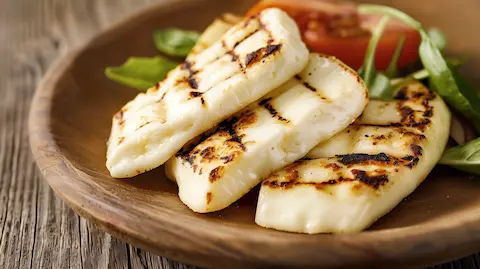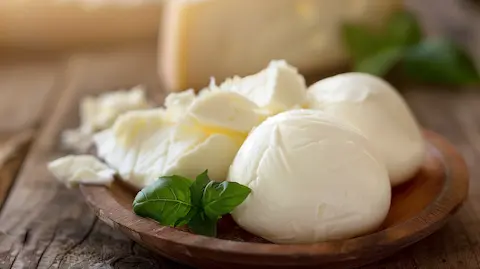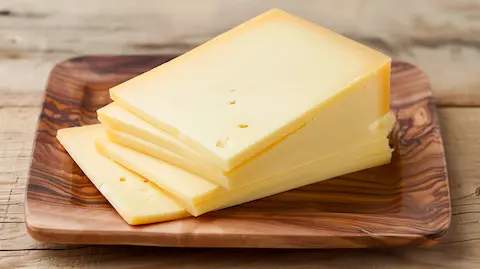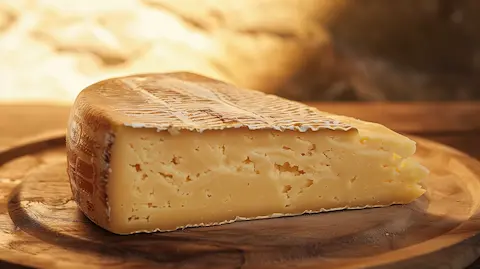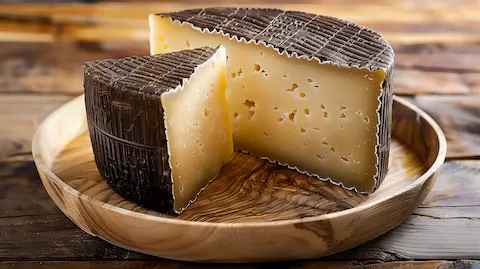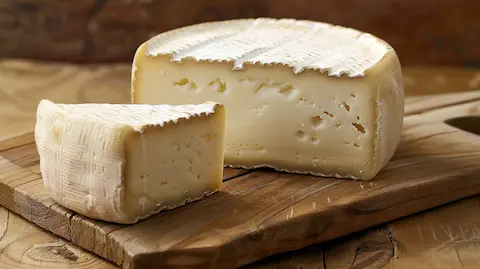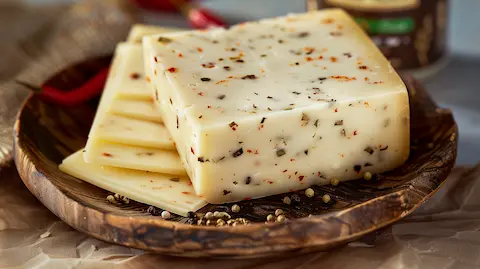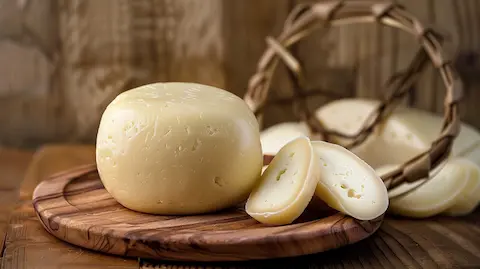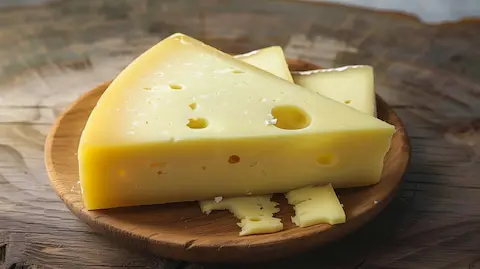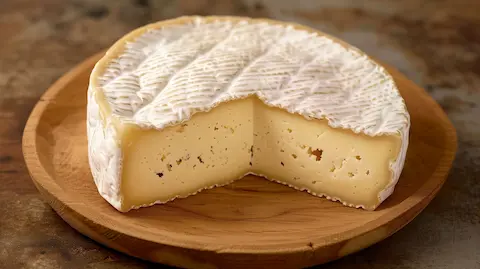American Cheese
American cheese, a processed cheese made from cheddar, Colby, or similar cheeses, is known for its creamy, salty taste and medium-firm consistency. It's crafted using sodium citrate which gives it a low melting point, making it a favorite for smooth textures in heated dishes. This cheese can be found in various hues, with yellow American cheese gaining its color from annatto. Invented in the early 20th century, American cheese has evolved from British colonists' cheddar-making practices to become a staple in the United States, particularly noted for its convenient meltability and uniformity.
From its inception in the 1910s by James L. Kraft, who patented the process in 1916, to its widespread presence in American kitchens and restaurants, this cheese has a storied history. While it has faced criticism for its departure from traditional cheese-making methods, American cheese remains a versatile component in numerous dishes, celebrated for its ability to meld into a creamy consistency without separating. Despite the debates surrounding its authenticity, American cheese includes more milk and cheese in its composition than some other food products contain their namesake ingredients, making it a genuine, if unique, member of the cheese family.
How is American Cheese made?
American Cheese is made by blending cheddar, Colby, or similar cheeses with emulsifiers, then heating the mixture to at least 150 °F (66 °C) for 30 seconds or more to pasteurize it. This process creates a product that has a uniform consistency and a stable shelf life. The addition of sodium citrate allows the cheese to melt smoothly without becoming greasy, making it ideal for a variety of culinary uses.
Production Process of American Cheese
| Step | Ingredients | Method | Temperature | Duration |
|---|---|---|---|---|
| 1. Blending | Cheddar, Colby, or similar cheeses | Grind and combine cheeses | Room temperature | Variable |
| 2. Emulsifying | Sodium citrate, water | Add emulsifiers to cheese mixture | Room temperature | Until homogeneous |
| 3. Heating | Cheese and emulsifier mixture | Pasteurize the mixture | 150 °F (66 °C) | At least 30 seconds |
| 4. Cooling and Forming | Pasteurized cheese mixture | Cool and form into slices or blocks | Below 40 °F (4 °C) | Until solidified |
| 5. Packaging | Sliced or blocked cheese | Individually wrap or stack | Room temperature | Variable |
What does American Cheese taste like?
american cheese tastes like a milder version of cheddar with a creamy and salty profile. Its medium-firm texture and uniform meltability make it a versatile ingredient in the kitchen. The flavor can vary slightly depending on whether it's made from cheddar, Colby, or a combination of similar cheeses, and whether it has been seasoned with ingredients like annatto.
American Cheese Profile
Delving into the characteristics of American cheese reveals a profile that is as unique as its history. This cheese is a product of ingenuity, designed to satisfy a demand for consistency and convenience in food preparation. Below is a snapshot of American cheese's distinctive features:
- Made from: Cheddar, Colby, or similar cheeses
- Country of origin: United States
- Family: Processed cheese
- Type: Semi-soft
- Texture: Smooth and creamy
- Rind: None
- Colour: Yellow or white; yellow is colored with annatto
- Flavour: Mild, creamy, and salty
- Aroma: Mild with a hint of milkiness
- Vegetarian: Often not, due to the use of animal-based enzymes
- Producers: Various, including major brands and generic labels
- Safe for dogs: Not recommended due to lactose content and additives
- PDO status: Not applicable
Origin: Where does American Cheese come from?
American cheese originates from the United States, where it was developed in the early 20th century. Its creation was influenced by British colonists' cheddar-making practices and the American spirit of innovation. By blending traditional cheese with emulsifiers and heat, a new, more consistent product was born, one that catered to the American palate and lifestyle. American cheese has since become a symbol of American cuisine, known for its utility and presence in classic dishes.
How to store American Cheese?
Storing American cheese properly is key to maintaining its quality and extending its shelf life. Keep American cheese refrigerated at a temperature below 40°F (4°C) to preserve its flavor and texture. For best results, wrap the cheese in parchment paper followed by aluminum foil or plastic wrap to protect it from air and moisture, which can lead to spoilage. If you have a large block of American cheese, consider cutting it into smaller portions before storing, so you only expose what you'll use soon to air.
- Refrigeration: Store in the refrigerator, wrapped in parchment and then foil or plastic.
- Portioning: Cut into smaller pieces to minimize exposure to air.
- Avoiding Contaminants: Keep away from strong-smelling foods to prevent odor absorption.
- Sealing: Ensure the wrapping is tight to keep out moisture and other contaminants.
- Monitoring: Check regularly for any signs of spoilage and use promptly.
How long does American Cheese last?
American cheese's shelf life varies depending on storage conditions. When stored properly in the refrigerator, an unopened package can last for several months, while an opened package should be consumed within two weeks for optimal quality. Freezing American cheese is possible, though it may alter the texture, making it crumblier, and is best used for cooked dishes upon thawing.
| Storage Location | Unopened Package | Opened Package | Frozen |
|---|---|---|---|
| Outside | Less than 2 hours | ||
| Fridge | 2-3 months | 1-2 weeks | |
| Freezer | 6-8 months | 6-8 months | Texture becomes crumbly; flavor may diminish. |
Is American Cheese pasteurized?
Yes, American cheese is pasteurized. The production process includes heating the cheese to at least 150 °F (66 °C) for 30 seconds or more, ensuring the destruction of harmful bacteria and making it safe for consumption.
Can you freeze American Cheese?
Yes, you can freeze American cheese. Freezing may change its texture, often resulting in a crumblier consistency, but it will extend the cheese's life for use in cooked dishes. Wrap the cheese tightly in plastic wrap or aluminum foil before placing it in the freezer to best preserve its quality.
How do you know if American Cheese has gone bad?
To determine if American cheese has spoiled, look for signs like an off smell, mold growth, or a change in color. Eating moldy American cheese can lead to digestive discomfort, so discard any cheese that shows evidence of mold. Always inspect cheese before consumption to ensure safety.
Exploring the characteristics of American cheese reveals a profile that is as unique as its history. This cheese is a product of ingenuity, designed to satisfy a demand for consistency and convenience in food preparation. Below is a snapshot of American cheese's distinctive features:
- Made from: Cheddar, Colby, or similar cheeses
- Country of origin: United States
- Family: Processed cheese
- Type: Semi-soft
- Texture: Smooth and creamy
- Rind: None
- Colour: Yellow or white; yellow is colored with annatto
- Flavour: Mild, creamy, and salty
- Aroma: Mild with a hint of milkiness
- Vegetarian: Often not, due to the use of animal-based enzymes
- Producers: Various, including major brands and generic labels
- Safe for dogs: Not recommended due to lactose content and additives
- PDO status: Not applicable
Alternatives to American Cheese
While American cheese holds a special place in many hearts and dishes, there are occasions when a substitute may be desired. Whether you're looking for a different flavor profile, a cheese with a higher melting point, or a non-dairy option, there are several alternatives that can provide similar qualities to American cheese. The following table offers a detailed look at some of these substitutes, along with reasons why they might serve as a fitting replacement in your culinary creations.
Substitutes for American Cheese
| Cheese | Texture | Flavor | Melting Point | Best Used In |
|---|---|---|---|---|
| Cheddar | Semi-hard | Rich, nutty, sharper than American cheese | Medium | Burgers, sandwiches, macaroni and cheese |
| Monterey Jack | Semi-soft | Mild, slightly tangy | Low | Quesadillas, grilled cheese, nachos |
| Provolone | Semi-hard | Mild, creamy with a slight tang | Medium | Subs, pizza, casseroles |
| Mozzarella | Semi-soft to soft | Mild, milky | Low | Pizza, lasagna, stuffed shells |
| Gouda | Semi-soft to hard | Rich, buttery, slightly sweet | Medium | Grilled cheese, cheese boards, sandwiches |
| Swiss | Firm | Nutty, sweet | Medium | Reuben sandwiches, fondue, burgers |
| Vegan cheese alternatives | Varies | Depends on brand and ingredients | Varies | Dairy-free dishes, vegan sandwiches, plant-based pizzas |
American Cheese Popular Comparison
Cheddar cheese is often compared to American cheese due to their shared origins and presence in numerous dishes.
Comparative Profile of American Cheese and Cheddar
| Cheese | Origin | Milk Source | Texture | Flavor | Aging Time | Uses |
|---|---|---|---|---|---|---|
| American Cheese | United States | Cow's milk | Semi-soft | Mild, creamy, salty | None | Burgers, sandwiches, mac and cheese |
| Cheddar | England | Cow's milk | Semi-hard to hard | Mild to sharp, depending on age | 2 months to several years | Charcuterie boards, sandwiches, sauces |
How to Use American Cheese
Optimizing the use of American Cheese in your cooking involves understanding its melting properties and flavor profile. It's a staple for creating a creamy texture in heated dishes due to its low melting point, courtesy of emulsifiers like sodium citrate. Whether you're aiming for a velvety cheese sauce or a gooey sandwich filling, American Cheese is an excellent choice. When slicing American Cheese for a platter or sandwich, it's best to cut it cold, as it can become too soft at room temperature, making it difficult to handle. Use a sharp knife or cheese slicer for even, clean cuts.
| Use | Description |
|---|---|
| Grilled Cheese Sandwiches | The cheese melts uniformly, creating the classic American grilled cheese texture. |
| Cheeseburgers | Adds a creamy, tangy layer that complements the savory flavors of the burger. |
| Macaroni and Cheese | Creates a smooth, rich sauce that clings to pasta for a comforting dish. |
| Cheese Dips | Ensures a lump-free consistency, perfect for dipping chips or vegetables. |
| Cheese Omelets | Integrates seamlessly into eggs, providing a moist, creamy filling. |
How to Serve American Cheese
Serving American Cheese at its best involves presenting it at a temperature where its texture and flavor can be fully appreciated. For cold dishes, remove the cheese from the refrigerator 20 minutes before serving to allow it to reach a pliable consistency. In hot applications, American Cheese should be added at the end of cooking to avoid overheating, which can cause the cheese to lose its smooth texture. When included in a cheese platter, pair it with milder accompaniments like crackers or bread, so its subtle creaminess can shine.
Recipes Using American Cheese
Why is American Cheese a good fit for many recipes? Its creamy texture and ability to melt smoothly make it a versatile ingredient for a variety of dishes. Whether you're looking to add a gooey touch to a classic sandwich or create a rich, velvety sauce, American Cheese is a perfect choice. Here are some popular recipes where American Cheese shines:
- Grilled Cheese Sandwich: The cheese melts uniformly, providing the quintessential oozy grilled cheese experience.
- Cheeseburgers: Melts perfectly over a hot patty, adding a creamy, tangy layer that complements the meat.
- Macaroni and Cheese: Ideal for creating a creamy cheese sauce that clings to the pasta for a classic comfort dish.
- Cheese Dips: Ensures a smooth consistency, perfect for a crowd-pleasing appetizer.
- Cheese Omelets: Integrates into the eggs, providing a moist, creamy filling that elevates the breakfast staple.
- Loaded Nachos: Drapes over tortilla chips, providing a satisfying melt that's essential for this snack favorite.
American Cheese nutrition data
Nutritional understanding of American Cheese is important for those mindful of their dietary intake. There are 371 calories in American Cheese per 100g. This cheese also contributes protein and calcium to one's diet, but it is high in saturated fats and sodium, which should be considered in the context of an overall balanced diet. Below is a nutritional breakdown for American Cheese:
| Nutrient | Amount per 100g | % Daily Value* |
|---|---|---|
| Calories | 371 | 18.55% |
| Total Fat | 31g | 47.69% |
| Saturated Fat | 19g | 95% |
| Trans Fat | 0.5g | - |
| Cholesterol | 100mg | 33.33% |
| Sodium | 1395mg | 58.13% |
| Total Carbohydrates | 5.1g | 1.7% |
| Dietary Fiber | 0g | 0% |
| Sugars | 3.2g | - |
| Protein | 22g | 44% |
| Calcium | 700mg | 70% |
| Iron | 0.4mg | 2.22% |
* Percent Daily Values are based on a 2000 calorie diet. Your daily values may be higher or lower depending on your calorie needs.
Regarding the paragraph under the heading "Alternatives to American Cheese":While American cheese holds a special place in many hearts and dishes, there are occasions when a substitute may be desired. Whether you're looking for a different flavor profile, a cheese with a higher melting point, or a non-dairy option, there are several alternatives that can provide similar qualities to American cheese. The following table offers a detailed look at some of these substitutes, along with reasons why they might serve as a fitting replacement in your culinary creations.
What's next? WhatCheese insights
If you are a connoisseur of American Cheese, or simply a curious foodie, you'll find that the best selections are often found where cheese culture is celebrated. Specialty cheese shops and delis across the United States often stock high-quality American cheese, with staff who can provide valuable insights into each cheese's unique characteristics. Moreover, renowned vineyards across the country, such as those in California's Napa Valley, offer cheese tastings that often feature American Cheese, allowing for an exploration of its pairing with fine wines.
If you are looking to deepen your appreciation for American Cheese, keep an eye out for food festivals and events that celebrate this beloved dairy product. From the Wisconsin Cheese Festival to the California artisan cheese Festival, these events are fantastic opportunities to taste a variety of American cheeses, engage with cheesemongers, and learn about the cheese-making process. Additionally, these gatherings are an excellent place to discover new and exciting ways to incorporate American Cheese into your culinary repertoire.
If you are interested in the ethical and sustainable aspects of cheese production, it's worth exploring American Cheese options that prioritize these values. Many producers are now focusing on organic ingredients and more humane animal husbandry practices. By choosing these products, you can enjoy American Cheese while supporting responsible farming and production methods.
For those who enjoy the medium-firm texture and creamy flavor profile of American Cheese, you may also find pleasure in exploring cheeses like Havarti, Muenster, and young Gouda. These varieties offer similar meltability and are excellent for cooking, snacking, or inclusion on a cheese platter.

